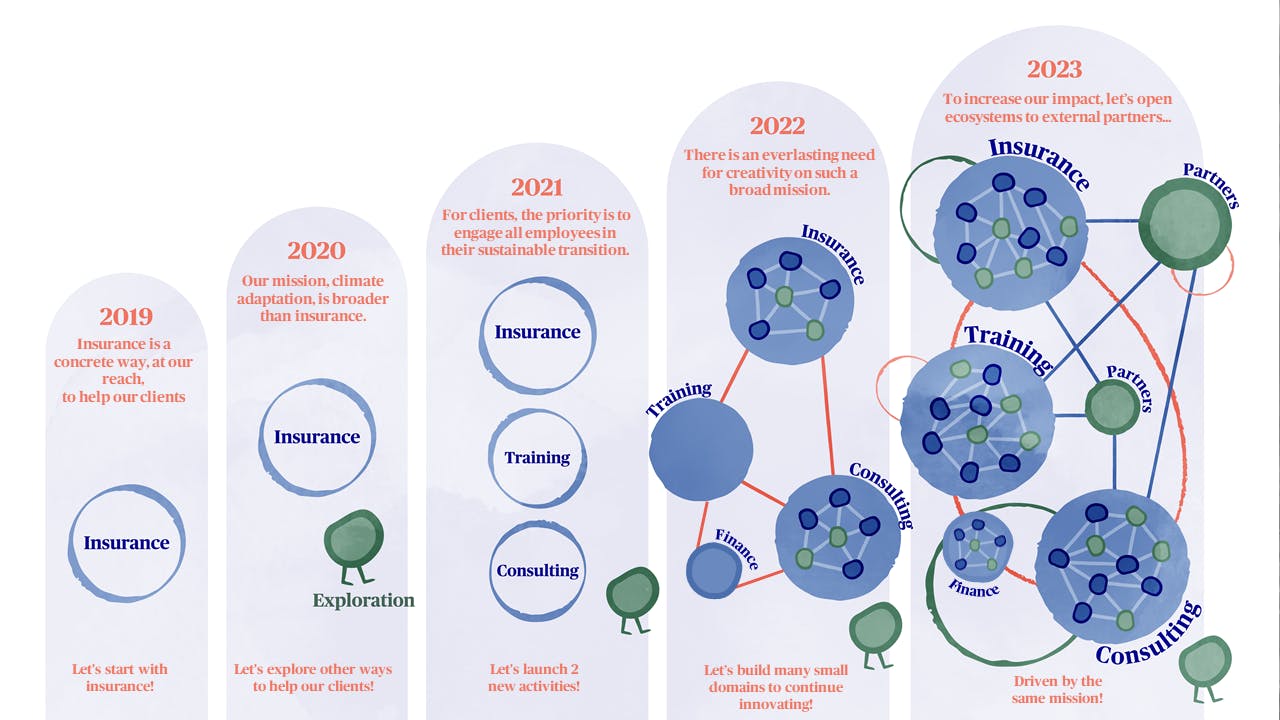

Antoine DenoixChief Executive Officer of AXA Climate
September 22, 2022
Companies are living beings
For companies to succeed in their continuous adaptation, they must become living systems, and follow the laws that apply to them. This movement is what we call regeneration.
6 minutes
This article is the first of a new series of AXA Climate articles. Its intention is to inspire and lead as many organisations as possible down the path of the ''living'' company. Each article will explore a specific dimension of how a living system works. To do so, we will humbly start from what we know, namely AXA Climate. Thankfully, several other companies have already started the same journey.
What we have noticed in companies
Today's world requires companies to continuously adapt their culture, organisation and business model. To survive in this exponentially complex world of climate and ecological crises, it is necessary to take multiple simultaneous and rapid actions.
This adaptation does not have the attributes of the classic transformations of recent decades, including digital transformation. For digital, action A (e.g., investing in a mobile application) induces action B (e.g., improving customer satisfaction). Certainly, the execution must be successful, but the consequences are relatively predictable.
For the ecological transition, action A (e.g., developing a wind farm) induces action B (e.g., the rush of Chinese and American manufacturers to buy Balsa, a light wood, 75% of which is produced in Ecuador) and C (e.g., massive illegal deforestation), which, in return, induces D (e.g., oppressed Ecuadorian natives) demeaning action A, which was positive in its initial intention. Butterfly effects, big time.
We deal with complex systemic issues. The consequences in cause/effect mode often elude us a priori; it is less necessary to foresee than to adjust quickly, with precision, in harmony with our ecosystem...
Most big companies are not ready for this continuous adaptation. Regardless of the sector of activity and the good intentions of those who run them, the obstacle is much more profound. It has to do with the very conception of the company as an organisation.
Since the industrial era, our companies have been conceived and operated as powerful machines in which every component must be under control. This vision is the result of a long cultural process and of a Western philosophy built on the teachings of Descartes, Bacon and others. It places a man as a subject, surrounded by objects, for whom the major concern is control. This vision has provided many advantages - by breaking things down into silos, we have developed very specialised expertise (e.g., a car, a chemical process, an agricultural practice, etc.), which has resulted in considerable progress for our collective quality of life. This need for control is reflected in the way in which companies present their organisations through organisational charts.
Organisational charts take the form of closed boxes that form vertical pyramids, with the eye drawn quickly and understandably upwards towards the top box. The main and logical challenge for these organisations' men and women is to climb the pyramid.
In mechanistic logic, this top box corresponds to the architect, the creator. Moreover, it is when the names of the leaders in the top box change, that the rest of the organisation chart changes in a domino effect, within a relatively short time. In an organisational chart, the connections between teams are represented by arrows that represent hierarchical authority (and not the frequency of work, collaboration, etc.). The connection of a team with the rest of the organisation is thus reduced to an arrow coming from the bottom and going up. The succession of different organisational charts in an organisation over time does not represent an intelligible and logical story. The organisational chart is a fixed response to a temporary issue of control in the company. Looking at an organisational chart, it is very difficult to deduce the purpose, vitality or even the values of a company.
This is where the difficulty arises.
Faced with a multitude of crises, a machine can be repaired. It is possible to change its parts and optimise its functioning. But a machine cannot adapt itself. Our conviction: to adapt, companies must reflect and organise themselves not as machines but as living beings.
What we can learn from the living
Living organisms are used to continuous adaptation, both on a microscopic and macroscopic scale. The history of the universe is nothing but a succession of adaptation jumps through the emergence of new forms that cannot be reduced to those that came before them: luminous and dark matter, expanding following the Big Bang; elementary particles (quarks and leptons) to allow the emergence of protons and neutrons that will form atoms; the implosion under the effect of gravity of hydrogen and helium allowing the creation of stars; bacteria capable of evolving into cells and then into multi-cells to create life; the chlorophyll cell capable of synthesising the energy of the sun for the creation of the first plants...
Following the same method as for a company, the living can reveal the ways it organises itself. Or rather its way of organisation. Since it is a pattern, identical laws are found, in fractal form, at different scales.
Living systems (e.g., a neural network, a forest, the organs of a mammal...) take the form of interconnected ecosystems without any notion of verticality. The living entities that constitute them are rather represented by round shapes, and the connections that interconnect them are numerous, two-way, and with many retroactions.
The growth of an entity induces the growth of the ecosystem to which it contributes and vice versa. This is the fundamental principle of a living system: it can only grow if it allows each living entity that constitutes it to pursue its essence, its purpose, and the reason for being alive. The very boundaries of ecosystems are porous. The change of one entity, however small, has multiple impacts on the rest of the ecosystem.
The living has no centre - the Universe bears witness to this, notwithstanding certain contemporaries of Galileo. In the end, the living system never stops moving to form a movie, an intelligible story. Imagine the dynamic development of a foetus or the expansion of the solar system...
Regenerating companies
For companies to succeed in their continuous adaptation, they must become living systems and follow the laws that apply to them. This movement is what we call #regeneration.
It affects all aspects of the enterprise, from its business model and its offerings to its culture and organisation. All of which require regeneration.
Companies become the ecosystems that allow each of the living systems that constitute it (employees, shareholders, customers, suppliers, local communities, the earth with its natural resources, etc.) to develop their full potential and grow with it. A regenerated company is not viewed through an organisational chart and the lens of control but through an ecosystem and the lens of vitality.
Drawing inspiration from a concrete achievement
For the past 4 years, AXA Climate's mission has been precisely climate and environmental adaptation. More than any other company, it was crucial that our organisation was designed, from the start, to be as adaptive as possible.
The infographic below allows you to read, through our continuous evolution, more than an organisation of authority, the story of a living entity, growing in consciousness, adapting continuously and repeatedly since its birth, guided by its mission.

In practical terms, this continuous adaptation requires support and a flexible and demanding framework. A sort of analogy with the laws of physics for the living world.
They are our rituals - a set of transparent, precise rules that provide a framework for our collective work on essential subjects and that carry regeneration: recruitment, performance, remuneration, development of skills, team life...
Here are some concrete rituals that guide our organisation:
The performance bonus is based solely on collective objectives, to give priority to the interests of a larger ecosystem over smaller living systems.
The salary increase reflects skills acquisition only, not performance. The How did you grow?
question. Individual skills are the key drivers of AXA Climate capabilities in the short, medium and long term.
Each week, 30 minutes of mandatory feedback sessions are organized between 2 team members randomly selected to trigger regular positive feedback loops.
At any moment, a squad of team members can emerge to take decisions related to specific challenges (e.g., new values, carbon footprint, salary increase...). Every team member can volunteer to contribute, and each decision taken by the squad will be automatically applied without CEO approval (as long as they are not related to our purpose, business plan and shareholders management).
Every year, the ecosystems visually map the domains that make them up, and their evolution is projected over time; every 4 months, the domains are recombined, and on the team’s initiative, some will appear, and others disappear to boost their impact. Each domain has a simple mission (i.e., it can be easily understood by a new AXA Climate on day one), 3 key results (i.e., written in passive voice to enable a straightforward answer: yes, we did it
or no, we failed
) and 3 connections to other domains essential to facilitate collaboration.
On an ongoing basis, the work of a small team (including the CEO) consists of carrying out vitality checks on certain domains to ensure that there is a good flow of energy - domains with more than 10 employees are, for example, systematically divided into smaller domains, in order to gain greater clarity in each person's mission, and therefore greater clarity and effectiveness
Our organisation is not evolving too fast
, but gradually, and therefore almost painlessly, to align itself with our purpose. We are only at the beginning of the adventure, but this living organisation is our best asset on this journey.
To be continued!
The content of this article reflects the opinions of the author concerned and not necessarily those of the AXA Group.



